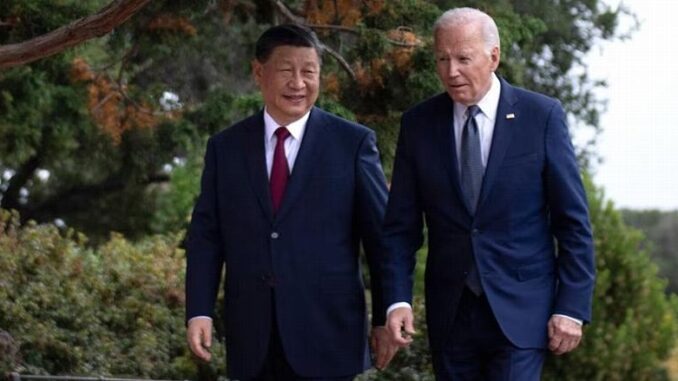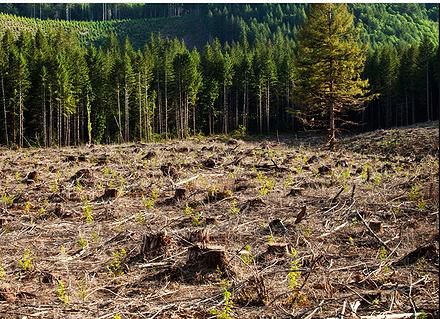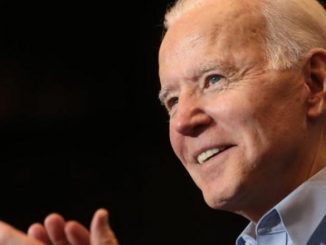
WOODSIDE, California, November 20, 2023 (ENS) – President Joe Biden and China’s President Xi Jinping are long-time acquaintances, and despite recent tensions, their in-person talks on November 15 at the Filoli Estate in Woodside yielded some advances for the environment.
Meeting for the first time in a year, Presidents Biden and Xi reaffirmed their commitments of 2021 to work jointly and together with other countries to address the climate crisis.
Expressing alarm at the scientists’ warnings, the two leaders stated, “The United States and China recognize that the climate crisis has increasingly affected countries around the world. Alarmed by the best available scientific findings including the IPCC Sixth Assessment Report, the United States and China remain committed to the effective implementation of the UNFCCC and the Paris Agreement, reflecting equity and the principle of common but differentiated responsibilities and respective capabilities, in light of different national circumstances, to achieve the Paris Agreement’s aim in accordance with its Article 2 to hold the global average temperature increase to well below 2° C and to pursue efforts to limit it to 1.5 degrees C, including efforts to keep 1.5° C within reach.”
The United States and China stated that they remain committed to the effective implementation of the Paris Agreement and decisions made under it, including the Glasgow Climate Pact and the Sharm el-Sheikh Implementation Plan.
This year’s United Nations climate summit, COP28, is happening from November 30 through December 12 in Dubai, United Arab Emirates.
In their joint statement, both China and the United States stressed the importance of COP 28 in responding meaningfully to the climate crisis during this critical decade and beyond.
They are aware of the important role they play in terms of both national responses and working together cooperatively to address the goals of the Paris Agreement and promote multilateralism.
They will work together and with other Parties to the UN Framework Convention on Climate Change, UNFCCC, and the Paris Agreement “to rise up to one of the greatest challenges of our time for present and future generations of humankind.”

The United States and China announced that they have decide to operationalize the Working Group on Enhancing Climate Action in the 2020s, to engage in dialogue and cooperation to accelerate concrete climate actions during this decade.
The Working Group will focus on the areas of cooperation that have been identified in the Joint Statement and the Joint Declaration, including: energy transition, methane, circular economy and resource efficiency, low-carbon and sustainable provinces/states and cities, and deforestation, as well as any agreed topics.
The Working Group will carry out information exchanges on policies, measures, and technologies for controlling and reducing emissions, share their respective experiences, identify and implement cooperative projects, and evaluate the implementation of the Joint Statement, the Joint Declaration, and this Statement.
The Working Group is co-led by the two special envoys on climate change, with the participation of officials from the relevant ministries and government agencies of the two countries.
Energy Transition Means Renewables
Both countries support the G20 Leaders Declaration to pursue efforts to triple renewable energy capacity globally by 2030. They said that they intend to “sufficiently accelerate renewable energy deployment in their respective economies through 2030 from 2020 levels so as to accelerate the substitution for coal, oil and gas generation, and thereby anticipate post-peaking meaningful absolute power sector emission reduction, in this critical decade of the 2020s.”
Daniel Kammen, a professor of energy at the University of California, Berkeley, told the China state-run news outlet “China Daily” that it is important for the United States and China to restart talk about environmental cooperation, and also launch agreements that other countries can join.
One of the key goals is the commitment to help all countries, not just the United States and China, triple the amount of renewables employed by 2030, Kammen said.
Both sides agree to restart the U.S.-China Energy Efficiency Forum to deepen policy exchanges on energy-saving and carbon-reducing solutions in key areas including: industry, buildings, transportation, and equipment.
The United States and China stated their intentions to recommence bilateral dialogues on energy policies and strategies, carry out exchanges on mutually agreed topics, and facilitate track II activities to enhance pragmatic cooperation.
The two countries aim to advance at least five large-scale cooperative carbon capture, usage and storage projects each by 2030, including from industrial and energy sources.
Methane and Other Non-CO2 Greenhouse Gas Emissions
The two countries will implement their respective national methane action plans and intend to elaborate further measures, as appropriate.

The two countries will immediately initiate technical working group cooperation on policy dialogue, technical solutions exchanges, and capacity building, building on their respective national methane action plans to develop their respective methane reduction actions/targets for inclusion in their 2035 Nationally Determined Contributions and support each country’s methane reduction and control progress.
The two countries intend to cooperate on respective measures to manage nitrous oxide emissions.
Both countries intend to cooperate in promoting relevant policies and measures and the deployment of technologies to enhance synergy of controlling greenhouse gas emissions and air pollutants, including nitrogen oxides, NOx, and volatile organic compounds, VOCs.
The two countries intend to work together under the Kigali Amendment to the Montreal Protocol on Substances that Deplete the Ozone Layer to phase down hydrofluorocarbons, HFCs. And they committed to ensure application of “ambitious minimum efficiency standards for all cooling equipment manufactured.”
HFC refrigerant gases are considered the third generation of fluorinated refrigerant gases. They were developed to be a more environmentally-friendly definitive alternative to chlorofluorocarbons, CFCs, and hydrochlorofluorocarbons, HCFCs, since they both deplete the ozone layer, but the depletion potential of HFCs is zero.
Circular Economy and Resource Efficiency
Recognizing the importance of developing circular economy and resource efficiency in addressing the climate crisis, relevant government agencies of the United States and China intend to conduct a policy dialogue on these topics as soon as possible and support enterprises, universities, and research institutions of both sides to engage in discussions and collaborative projects.
The United States and China are determined to end plastic pollution and will work together and with others to develop an international legally binding instrument on plastic pollution, including the marine environment.
Cooperation With States and Cities
The United States and China will support climate cooperation among states, provinces, and cities with regard to areas including, among others, the power, transportation, buildings, and waste sectors.
Both sides will facilitate subnational governments, enterprises, think tanks, and other stakeholders to actively participate in the cooperation.
The two countries will meet periodically, as agreed, for policy dialogue, best practices sharing, information exchange, and to facilitate cooperative programs.
Both sides welcome with appreciation existing subnational cooperation between the two countries and encourage states, provinces, and cities to promote practical climate cooperation.
In addition, the United States and China intend to hold a high-level event on subnational climate action in the first half of 2024.
Reversing Forest Loss

Both sides commit to advance efforts to halt and reverse forest loss by 2030, including by fully implementing through regulation and policy, and effectively enforcing, their respective laws on banning illegal imports.
They intend to engage in discussions and exchanges, including under the Working Group, on ways to improve efforts to strengthen implementation of this commitment.
Nearly 70 percent of forests cleared for agriculture around the world are cut illegally, and the annual volume of greenhouse gas released by their removal is larger than India’s emissions from fossil fuels, WWF researchers found.
The logging is not only in China. According to a WWF study, China’s imports of agricultural commodities drive more deforestation globally than any other market, including the United States and the European Union combined.
2035 Nationally Determined Contributions
Nationally Determined Contributions, or NDCs, are countries’ self-defined national climate pledges under the Paris Agreement, detailing what they will do to help meet the global goal to pursue a temperature increase of no more than 1.5°Celsius above pre-industrial levels, and what they will do to adapt to climate impacts and ensure sufficient finance to support these efforts.
Reaffirming the nationally determined nature of NDCs, and recalling Article 4.4 of the Paris Agreement, both countries’ 2035 NDCs will be economy-wide, include all greenhouse gases, and reflect the reductions aligned with the Paris temperature goal of holding the increase in global average temperature to well below 2°C and pursuing efforts to limit the temperature increase to 1.5 degrees C.
UN’s Climate Summit COP28
The United States and China, with the United Arab Emirates, invite countries to a Methane and Non-CO2 Greenhouse Gases Summit at COP 28, which is taking place in Dubai, capital of the United Arab Emirates from November 30 through December 12.
The United States and China look forward to the first Global Stocktake under the Paris Agreement, which is a vital opportunity for the Parties to reflect on ambition, implementation, and cooperation, in line with the Paris temperature goal to hold the global average temperature increase to well below 2°C and pursue efforts to limit it to 1.5°C, and the Parties’ resolve to keep a 1.5°C limit on temperature rise within reach.
Both countries are committed to working with each other and with other Parties to adopt a consensus Global Stocktake decision.
In the view of both countries, this decision:
- – should reflect that there has been substantial positive progress toward achieving the objectives of the Paris Agreement, including that the Agreement has catalyzed action by both Parties and non-Party stakeholders and that the world is considerably better off in terms of its temperature trajectory than it would have been in the absence of the Agreement;
- – should take account of equity and be informed by the best available science, including the most recent IPCC reports;
- – should be balanced across thematic areas, include both retrospective and responsive elements, and be consistent with the design of the Paris Agreement;
- – should reflect that substantially more ambition and implementation on action and support will be needed to achieve the Paris Agreement’s goals, recognizing different national circumstances;
- – should send signals with respect to the energy transition (renewable energy, coal/oil/gas), carbon sinks including forests, non-CO2 gases including methane, and low-carbon technologies, etc.;
recognizing the nationally determined nature of NDCs and recalling Article 4.4 of the Paris Agreement, should encourage economy-wide 2035 NDCs covering all greenhouse gases; - – should reflect the critical importance of adaptation and be accompanied by a robust decision that delivers an ambitious framework for the global goal on adaptation — one that accelerates adaptation, including developing targets/indicators to enhance adaptation effectiveness; delivering early warning systems for developing country Parties; and strengthening adaptation efforts in key areas (e.g. food, water, infrastructure, health, and ecosystems);
- – should note the expectation of the developed countries that the $100 billion goal will be met in 2023, reaffirm the urging of developed country Parties to at least double their provision of adaptation finance; anticipate the adoption by COP 29 of the new collective quantified goal; and make finance flows consistent with the Paris Agreement goals;
should welcome with appreciation the recommendations of the Transitional Committee with respect to establishing funding arrangements to address loss and damage, including the establishment of a fund; and - – should emphasize the important role of international cooperation, including that the global nature of the climate crisis calls for the widest possible cooperation and that such cooperation is a critical enabler for achieving ambitious mitigation action and climate-resilient development.
Finally, the two countries pledged to further their dialogues, efforts, and collaboration to support the UAE Presidency for the success of COP28.
Featured image: U.S. President Joe Biden, right, and Chinese President Xi Jinping walk together after a meeting during the Asia-Pacific Economic Cooperation leaders’ week in Woodside, California, November 15, 2023. (Photo courtesy AFP via Voice of America)



